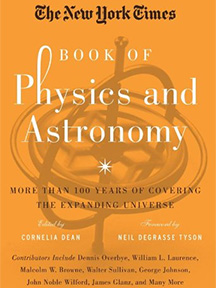By Jay M. Pasachoff
This wonderful collection of over 150 short articles from the pages of The New York Times over the past 120 years or so gives the flavor of scientific advance and brings heroes (including heroines) of science to the fore. Too fat to read in one sitting, the book is a delight for browsers.
My attention was first caught by the early articles about Marie Curie and her work, each taking one to four pages in the published book. We learn in one 1904 article about the 3,000 people who went to her lecture in Paris in which she demonstrated rays emitted by radium. In a 1921 article, we learn about her forthcoming visit to New York “to receive the gift of one gram of this very valuable element from American women.”
Editor Cornelia Dean’s introduction includes a mea culpa for the lack of timely coverage by The Times in so many instances, and even that they long “persistently misspelled the first name of the Danish theorist of the atom, Niels Bohr.” “Eventually, though,” she writes, “The Times got better at being right on top of things.”
Celebrity astrophysicist Neil deGrasse Tyson charmingly reports in his foreword that “During middle and high school, I clipped every article on physics and astrophysics that appeared in the daily New York Times and in its Sunday magazine.” Let us hope that today’s young students similarly save science articles that appear on their iPads, and even that they read in this book to fill them in about many things that they didn’t know about from the past century of science.
Heros of science reporting are honored by being collected here, including such Times experts as Walter Sullivan, Malcolm Browne, George Johnson, and, most recently Dennis Overbye. The last of that distinguished list brings us up to date in contemporary cosmology, with cosmic expansion and dark matter among the fascinating topics he covered.
My Astronomy 101 students have not, for the most part, heard of Prof. Röntgen and his rays, and if they could be brought to read the relevant essays in the book they would link him to the x-rays they have heard of. Einstein’s relativity, quarks, transistors, strong theory, atomic bombs, fusion (hot and cold), and the Hubble Space Telescope are among the topics covered.
The New York Times Book of Physics and Astronomy, subtitled “more than 100 years of covering the expanding universe,” is a wonderful collection that is fun to sample and to read.
Astronomer and author Jay M. Pasachoff is the director of Hopkins Observatory and Field Memorial Professor of Astronomy at Williams College. He is a Visitor in the Planetary Sciences Department of Caltech. Williams College is home to the Gamma of Massachusetts Chapter of Phi Beta Kappa.




